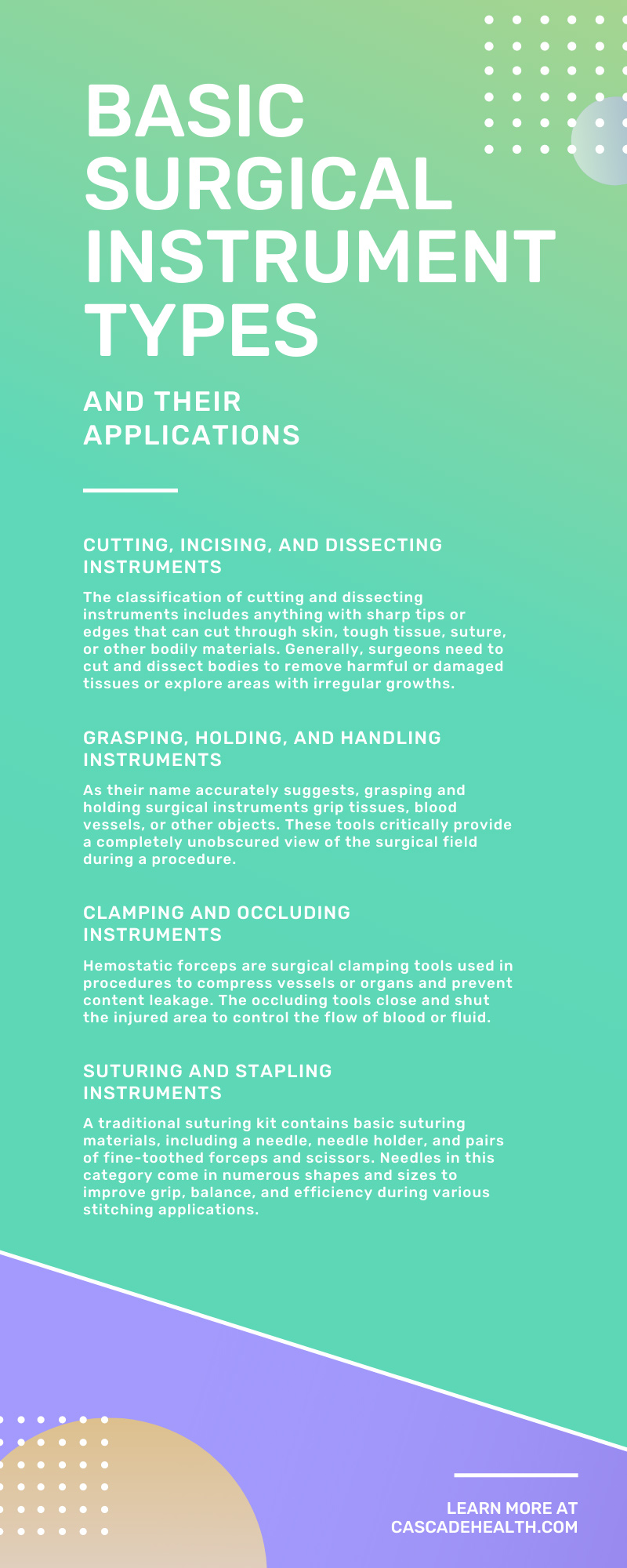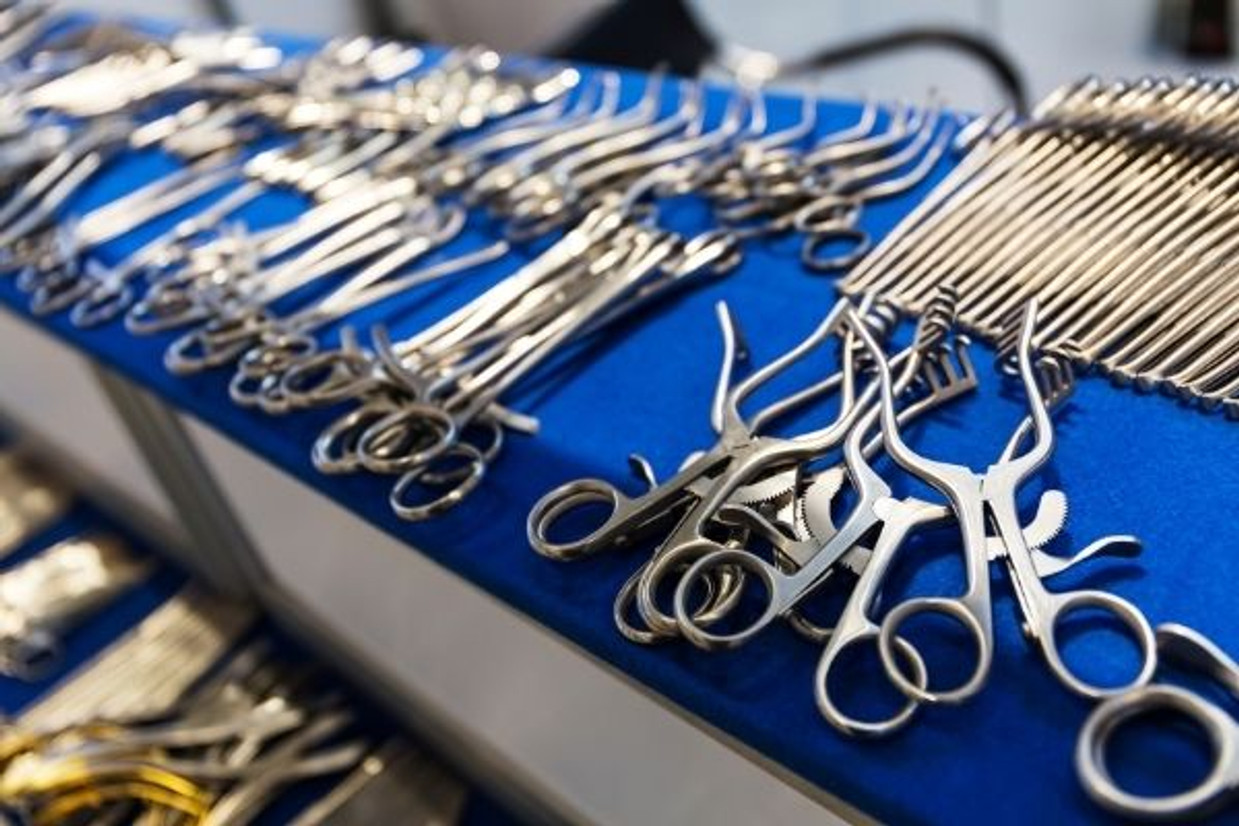Basic Surgical Instrument Types and Their Applications
Since ancient times, various instruments have been manufactured and used for surgical purposes. The physicians and surgeons of Greece and Rome were the first to introduce ingenious instruments that are still used around the globe today. These early healthcare specialists used cleverly designed devices crafted from iron, bronze, and silver. These tools included knives, scalpels, tweezers, forceps, lancets, probes, tubes, curettes, dilators, and more.
Most of these instruments were widely used during the Medieval era. As manufacturing techniques improved, so did the instruments’ form and structure, offering improved function and versatility. In the Renaissance and post-Renaissance, the enhanced skill and audacity of surgeons stimulated greater innovation and design than ever before.
In the present day, almost every specialization in the medical field utilizes an array of surgical instruments for modern applications. Let’s closely examine the classification of diverse surgical instruments by their clinical form and function. Read on for further information about the basic surgical instrument types and their applications.
What To Know About Surgical Instrument Use
No one can successfully perform a surgical procedure without properly cleaned and sterilized surgical tools. The classification and identification of surgical instruments are extensive and continually growing. Thousands of surgical-grade options are available for a plethora of purposes and procedures. Surgical-grade refers to reusable stainless steel instruments that offer the highest quality and efficiency in health care.
When selecting an instrument for surgical purposes, the key factors to consider include best practices, patient size, and duration of the intended use. Keep in mind that each surgical-grade tool is designed exclusively for an intended purpose and solely should be used for that application. Let’s review the basic surgical instrument types and their applications below.
Cutting, Incising, and Dissecting Instruments
The classification of cutting and dissecting instruments includes anything with sharp tips or edges that can cut through skin, tough tissue, suture, or other bodily materials. Generally, surgeons need to cut and dissect bodies to remove harmful or damaged tissues or explore areas with irregular growths.
These razor-sharp instruments have either single or double edges or blades to ensure a seamless cut. Those who handle these supplies should be very cautious to avoid possible accidents or injuries. Regular inspection is necessary to ensure safety and functionality before use.
Scalpels are cutting tools consisting of a blade and handle that physicians use to make a single incision. Surgeons often refer to scalpels by their blade number, which indicates their size. Conversely, scissors are straight or curved instruments for heavy-duty cutting or delicate dissection. Referred to directly by name, the most common types are Mayo scissors, Potts scissors, Iris scissors, or Metzenbaum scissors.
Grasping, Holding, and Handling Instruments
As their name accurately suggests, grasping and holding surgical instruments grip tissues, blood vessels, or other objects. These tools critically provide a completely unobscured view of the surgical field during a procedure.
Forceps are a common instrument of this type. These scissor-like tools grasp materials that are difficult for fingers to hold. People use forceps with toothed or untoothed tips to handle different tissues. Examples include smooth forceps, tissue forceps, thumb forceps, Allis forceps, and Adson forceps. After proper cleaning and sterilization, lubrication is key to ensure their locking mechanism opens and closes easily during use.
Clamping and Occluding Instruments
Hemostatic forceps are surgical clamping tools used in procedures to compress vessels or organs and prevent content leakage. The occluding tools close and shut the injured area to control the flow of blood or fluid. Hemostat locking devices can be angled, curved, or straight in design with assorted patterns. These crucial clamping instruments are essential for delicate operations in hospitals or specialty clinics.
Retracting and Exposing Instruments
Retractors are integral devices that help surgeons fully retract tissues without causing further trauma. These surgical instruments hold back organs or tissues to provide greater access to the operative field. By spreading open the edges of a wound or incision, exposing retractors helps to maintain the desired positioning throughout surgery.
Retractors may be manually handheld, clamped securely in place, or suspended on a robotic arm. Varying forms include Army Navy retractors, Weitlaner retractors, and Deaver retractors. Self-retaining retractors are the ideal instrument option to allow hands-free operations.
Suturing and Stapling Instruments
A traditional suturing kit contains basic suturing materials, including a needle, needle holder, and pairs of fine-toothed forceps and scissors. Needles in this category come in numerous shapes and sizes to improve grip, balance, and efficiency during various stitching applications.
In this classification, staplers and skin glues are some alternative surgical tool options for skin closures. The surgeon’s preference, the location of the injury, and the possible cosmetic outcome usually determines which tool the surgeons use. Surgical staplers and clip appliers are often used for closing terminal ends or internal connections. They are reliable and much quicker than certain suturing techniques.
Modern Surgical Instrument Manufacturing
The manufacturing of these surgical instruments is a well-developed craft. Newly-designed surgical approaches and procedures consistently influence the production process—and cause undoubtedly high demand. Nonetheless, newer manufacturing techniques successfully keep pace with advancements and innovations in the medical field.
For this reason, hospitals and healthcare facilities trust in the safety and dependability of surgical-grade instruments for life-changing or life-saving practices and procedures. Many tools and devices from trusted industry suppliers are readily available to today’s medical professionals. As surgical instruments comprise a greater portion of healthcare facilities’ budgets, selecting the right tools is essential to ensure positive patient outcomes.
Surgical-Grade Brands: Choose Cascade Health Care
Cascade Health Care supplies medical professionals and facilities with high-quality tools, supplies, and equipment. We offer a variety of surgical instruments for sale from industry-renowned brands: Miltex, Konig, and Vantage. Crafted out of durable stainless-steel material, any of these surgical-grade options are ideal for modern applications. Each surgical product meets the needs of specialized procedures or processes with quality assurance.
Shop through our selection of tools from reputable manufacturers today to ensure premier performance and safety when it matters the most. Reach out to our exceptional customer service team with any questions about product specifications or purchasing options.

Recent Posts
-
Exploring Recent Innovations in Doppler Signal Processing
Doppler technology has become an essential diagnostic tool in modern medicine, enabling healthcare p
-
Exploring Recent Innovations in Doppler Signal Processing
Doppler technology has become an essential diagnostic tool in modern medicine, enabling healthcare p


